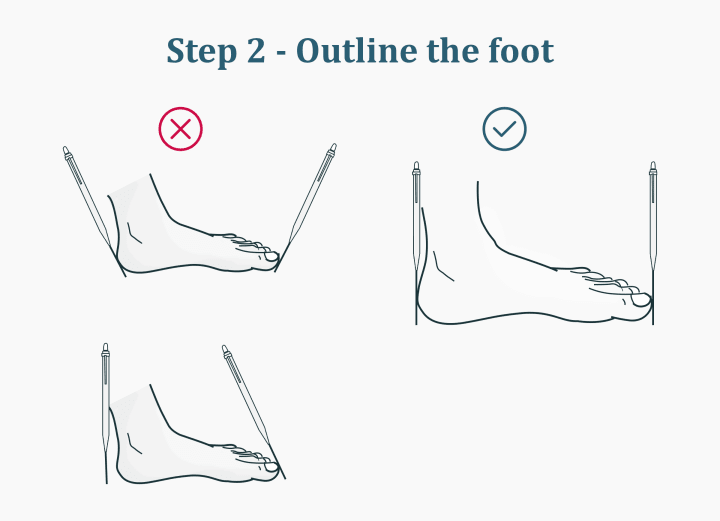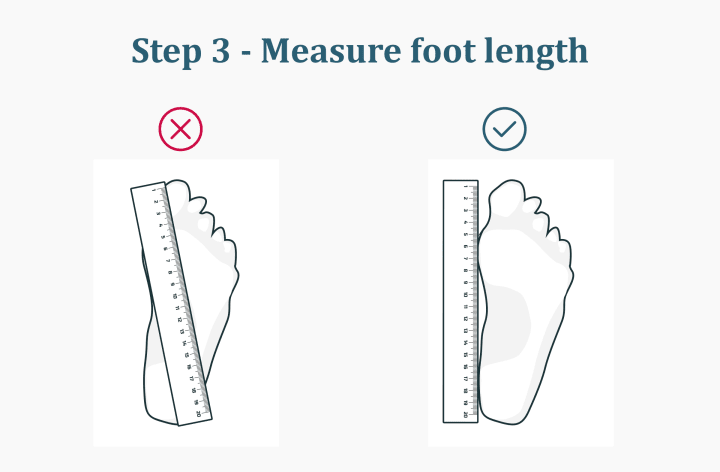This is one of the best instructions on this rather basic topic I’ve ever come across. Written by Olesya Kryakvina over at runrepeat.com
How to measure shoe size at home

Tips:
- Measure in the evening, when the foot is at its fullest shape
- Be barefoot or put on socks that you plan to wear with the new shoes
- Stand on a hard surface

Tips:
- ask a friend to help you
- stand straight with your weight equally distributed on both legs
- trace both feet because it’s normal for one to be longer than the other

Tips:
- measure the distance between two most prominent points (from back of the heel to the end of the longest toe)
- write down the numbers you get
- use measurements of the longer foot
Consider foot width
If the shoe length is right but you often get frustrated with the fit of shoes in your regular size (needing extra space or a more snug fit), chances are you need an alternative width.
Shoe width is even more complicated than size (length) because brands don’t provide reference charts for this parameter. You can only get a general idea of a shoe’s width based on the letter indications “B,” “D,” “2E,” etc.:
| Width | Women’s | Men’s |
|---|---|---|
| 4A (AAAA) | Extra Narrow | – |
| 2A (AA) | Narrow | Extra Narrow |
| B | Medium | Narrow |
| D | Wide | Medium |
| 2E (EE) | Extra Wide | Wide |
| 4E (EEEE) | XX-Wide | Extra Wide |
| 6E (EEEEEE) | – | XX-Wide |
Because there is no universal standard, it’s nearly impossible to determine the right width without trying the shoe on. But the rule of thumb is that there is approximately an ⅛ inch (3.18 mm) difference between widths.
The good news is that companies like Skechers, New Balance, Saucony, and Brooks often release their models in multiple width options.
How to know if the fit is right
Running shoes, gym trainers, sneakers, and most other types of footwear should tick the following boxes:
- Heel: locked in and not slipping out when you bend the foot, walk, or run
- Midfoot: snug but not tight, there should be no pinching
- Toebox: there is a thumb’s width space between your longest toe and the shoe’s front and the toes have enough room to splay sideways without pressure
Some niche sportswear such as track spikes, cycling shoes, and climbing footwear will have different fit standards as they require a snug, second-skin-like fit.
A shoe should feel right and comfortable straight from the box.Don’t rely on a break-in period to change the fit significantly.
Some issues like heel slipping, discomfort due to high arches, or a tendency to foot swelling can be helped with a customized lacing technique.
Measure your feet every year
And right before looking for new shoes.
Life is dynamic and so are our bodies and feet. A multitude of factors can impact your foot dimensions over time:
- significantly increased or decreased physical activity
- developing foot conditions like bunions, arthritis, edema, hammertoes
- gaining weight
- pregnancy
It can be hard to acknowledge that you need to get a full size bigger but a well-fitting shoe is key to your comfort and health.
Insole length does not determine shoe size
We have measured the insole length of 20+ running shoes in our lab, all in men’s US size 9.
The range goes from 271 to 287 mm (16 mm discrepancy!). We observed that the insole can be longer or shorter depending on the shoe’s toebox shape.
So, if you don’t have a chance to measure your feet, it is safer to reference the CM/CHN/JP/Mondo measurement listed on the shoe that fits you well.
Echoed from: https://runrepeat.com/guides/how-to-measure-shoe-size
